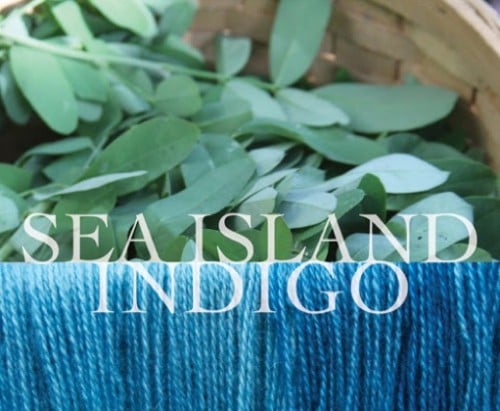272 years after the first successful indigo crop was planted in the Carolina colonies, Donna Hardy of Sea Island Indigo got an idea to research and track down the original strain of indigo plants that were grown in colonial Charleston. Her research and persistence located a few remaining varieties in isolated areas that had been grown for generations: a pretty but humble shrub hiding its secret blue dye.
Armed with a handful of seeds and the offer of a plot of land and free goat manure, Donna started her first crop of indigo and was overjoyed when she tested them to see that they yielded a rich and particularly intense blue color.
Word soon got out about her indigo project and she attracted the interest and backing of the Carolina Gold Rice Foundation, an organization dedicated to the preservation of agricultural practices, grains and foodstuffs native to the Carolinas. Their reach extends to other heirloom and historically important crops and in the 18th century, rice, indigo, sugar and cotton were vital to South Carolina’s economy. Together, Donna and the Carolina Rice Foundation are working diligently to ensure that heritage dye and fiber crops are researched, preserved and revitalized.
What was the main reason you wanted to re-grow Sea Island Indigo? (History, legacy? You like farming and sweating a lot?)
To be quite honest, the thought was, Why not? If it was successful 250 years ago, then why not now? Especially since we have outsourced so many of our textile jobs. Let’s bring it back to U.S. soil, if we can grow it and make a marketable product with it, we should do it. I’m talking about grown to sewn in the U.S.
But, the history and legacy are very compelling and have an almost “romantic” aura to it. And, yes, I like farming and playing in the dirt.
On your blog, you are telling the history of Eliza Lucas, a 16 year old girl who had to make her plantations successful for her family. Tell me how this story adds deeper meaning to a plant.
Eliza was a very strong young woman in an era of patriarchy and what she accomplished was remarkable, especially considering the era in which she lived. She is truly a “mighty girl” and a role model for women and girls today. You also have to consider her father and how he recognized and supported her curious mind and put his faith in her ability to manage three properties. The strain of indigo she grew has been identified and that is what we are growing.
What’s the main difference between Sea Island Indigo with another popular strain of indigo?
Sea Island Indigo is an Indigofera, Indigofera suffruticosa, to be specific. It’s in the legume family so it builds the soil by fixing the nitrogen in it. We hope to be able to put it into the summer cover crop rotation of local farmers. By doing this we will help the farmers enrich their soil and we will be able to cut the leaves and extract the indigotin for indigo. After we use the leaves they can be put back in the soil as a green biomass to also help enrich it. To me, it seems to be a win-win for everyone!
So why this retreat? What do you want people to take away from it?
I want people to get in touch with our history. And I just want to share this beautiful part of our country and Southern culture. And, most importantly, I want every one to have FUN!
To register for the 3 day Sea Island Indigo retreat in Charleston, go here!


